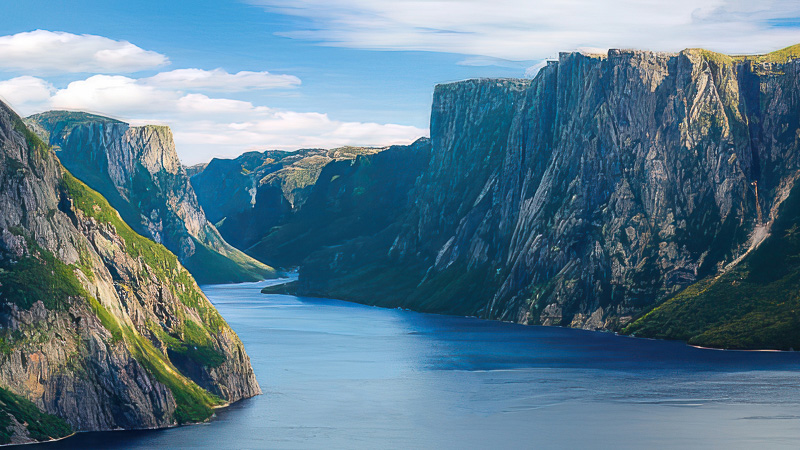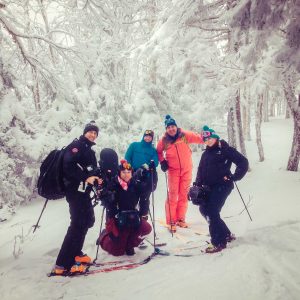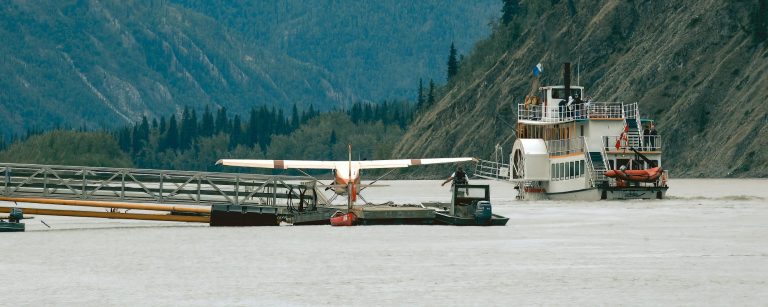Canada’s various landscapes and beautiful natural settings make the country a popular choice among filmmakers looking for exceptional locations. Canada’s landscapes range from the rough shoreline of the Gaspe Peninsula in Quebec to the wild and desolate beauty of the North Coast, making the country ideal for road trips filled with spectacular views. Other well-known highways include Alberta’s Icefields Parkway, Nova Scotia’s Cabot Trail, and Yukon’s own Dempster Highway. Canada’s picturesque road trip routes offer a wide variety of locations perfect for filming the country’s beautiful and varied natural surroundings, from the towering peaks of the Rocky Mountains to the sleepy fishing communities of the coast.
The Icefields Parkway in Alberta
This scenic route through the Canadian Rockies offers breathtaking views of glaciers, mountains, and lakes.

The Icefields Parkway is a cameraman’s paradise, with several scenic viewpoints from which to record the majesty of the Canadian Rockies on film. The parkway is a fantastic place to take photographs, with a wide variety of subjects available, from overhead views of the Columbia Icefield to detailed portraits of moose grazing in a meadow.
The ever-changing landscape along the winding road will capture your attention and spark new ideas as you move along. You could be recording the jagged, glacier-carved peaks that tower over the roadway one minute, and then the huge, open meadows of the alpine region the next.
The Icefields Parkway is like paradise on earth for people who are passionate about nature. Majestic elk and bighorn sheep, as well as elusive wolves and grizzly bears, are just some of the remarkable animals that call this area home. The Icefields Parkway is a wildlife photographer’s dream, with countless opportunity to capture everything from a mother bear teaching her cubs to fish to a herd of bison wandering freely through a valley.
The Cabot Trail in Nova Scotia
This winding coastal road offers stunning views of the Atlantic Ocean, as well as forests, cliffs, and beaches.
via the charming fishing communities and along the stunning Atlantic coastline of Cape Breton Highlands National Park. This road offers filmmakers countless possibilities to capture the breathtaking grandeur of the Nova Scotia environment.
A film director’s dream, the Cabot Trail’s raw and untamed shoreline makes for a captivating setting. The trail offers a breathtaking backdrop, from the rugged cliffs and crashing waves of the Atlantic Ocean to the quiet beaches and tranquil coves of the Bras d’Or Lakes.
Visitors interested in seeing the wide diversity of species that calls this part of Nova Scotia home will find the Cabot Trail to be a paradise. Photos and movies can be taken of whales jumping out of the water, moose browsing in the woods, and bald eagles flying over the cliffs. Several endangered bird species call the area home, including the piping plover, which you might spot if you’re lucky.
Cabot Trail is not only stunning because of its natural surroundings, but also because of the picturesque coastal towns and fishing villages that dot the route. The route offers a wealth of diverse settings in which to tell stories, from the hustle and bustle of a lobster fishing hamlet to the quiet beauty of a charming coastal town.
Sea-to-Sky Highway in British Columbia
This highway offers panoramic views of the ocean, mountains, and forests, as well as access to Whistler and other scenic destinations.
Filmmakers can take advantage of some of Canada’s most breathtaking natural beauty along the Sea-to-Sky Highway in British Columbia, which runs from Vancouver to the resort town of Whistler. Beautiful vistas of the Pacific Ocean, towering mountains, and verdant rainforest may be seen from the route.
The Sea-to-Sky Highway is a videographer’s dream, presenting countless opportunity to record the region’s beautiful scenery. The highway passes through a wide variety of scenic areas, from the towering peaks of the Coast Mountains to the luscious forests that cover the slopes.
The breathtaking vistas of the Howe Sound fjord along the Sea-to-Sky Highway are a major draw. Beautiful vistas of the sound’s turquoise waters and towering mountain cliffs can be seen from the highway, making it an ideal location for any film.
Shannon Falls, located along the Sea-to-Sky Highway, is another must-see destination. The falls are about 1,100 feet long and cascade down a granite cliff face, making them among the tallest in British Columbia. Filmmakers may capture the sheer power and beauty of nature in this stunning location.
Visitors interested in seeing black bears, cougars, and bald eagles, among other species, will find a veritable paradise along the Sea-to-Sky Highway. Keep your camera ready as you travel down the road in search of these magnificent animals so you can immortalize their grace and beauty forever.
The Viking Trail in Newfoundland and Labrador
This coastal route takes you through some of Canada's most historic and scenic sites, including Gros Morne National Park and L'Anse aux Meadows.

Filmmakers have a rare opportunity to capture the splendour of Canada’s easternmost province on the Viking Trail, a breathtakingly magnificent route that stretches over 500 kilometres along the Northern Peninsula of Newfoundland. The varied coastal terrain, historic rock formations, and quaint communities along the trail all have fascinating histories and cultures of their own to explore.
The Viking Trail offers a wealth of opportunities for filmmakers. The trail passes by some of the world’s most breathtaking scenery, from the Atlantic Ocean’s rocky cliffs and roaring waves to the interior’s tranquil forests and lakes.
Geological structures such as the tall cliffs of the Tablelands and the strange patterns of Arches Provincial Park are among the most eye-catching aspects of the scenery along the Viking Trail. The strange shapes and colours of these formations present a special challenge to cinematographers, but they also make for a breathtaking visual backdrop in any picture.
The many quaint towns and villages lining the Viking Trail are a testament to the region’s thriving and distinctive local culture, which complements the trail’s stunning natural scenery. Filmmakers can capture the colourful houses, distinctive dialects, and lively festivals of the local fishing communities, as well as the region’s rich history, which includes the Viking settlement at L’Anse aux Meadows and the ancient aboriginal cultures that have inhabited the area for thousands of years.
Dempster Highway in Yukon and Northwest Territories
This rugged road takes you through the heart of Canada's Arctic wilderness, passing through mountains, tundra, and permafrost.
Over 700 kilometres long, the Dempster Highway in the Yukon and Northwest Territories passes through some of Canada’s harshest and most pristine environment. The route is ideal for movies that call for vast and bleak vistas since it provides filmmakers with a tough opportunity to convey the splendour and isolation of the northern wilderness.
The Dempster Highway provides a filmmaker with a variety of stunning visual opportunities, from the stark and untamed beauty of the tundra to the eerie and surreal forms of the Arctic terrain. The roadway travels through the untamed wilderness that is home to a wide variety of animals, such as wolves, bears, caribou, and musk oxen, and provides stunning vistas of snow-capped peaks and steep valleys.
The extreme solitude and seclusion afforded by the Dempster Highway is one of its most outstanding characteristics. There are no cities or settlements along the roadway, giving travellers a genuine taste of the wilderness as they pass by huge stretches of undeveloped land. However, filmmakers must take special precautions to ensure that their crew and equipment can safely traverse this difficult and inaccessible terrain, which can be both a blessing and a challenge in terms of capturing the raw beauty and majesty of nature.
The Fundy Coastal Drive in New Brunswick
This scenic drive offers stunning views of the Bay of Fundy, as well as coastal cliffs, forests, and wildlife.
New Brunswick’s Fundy Coastal Drive, a road trip that stretches over 400 kilometres along the Bay of Fundy’s rough coast, provides filmmakers with a gorgeous setting for their movies. Along the route, you’ll see stunning sea cliffs, beautiful beaches, and quaint fishing communities that are brimming with history and culture.
If you’re a filmmaker looking for inspiration, the Fundy Coastal Drive has everything from breathtaking scenery to interesting local traditions to offer. All along the route, you’ll be treated to breathtaking views of the Bay of Fundy, from its dramatic sea cliffs and crashing waves to its peaceful beaches and secluded coves, ideal for staging tender moments between a couple.
Along with its stunning scenery, the Fundy Coastal Drive also boasts a vibrant and distinctive local culture that is represented in the many little towns and villages that dot the route. Filmmakers have the opportunity to portray the region’s colourful culture, including the Acadian heritage with its brightly coloured homes, distinctive cuisine, and lively festivals, as well as the region’s historical significance, including its part in the founding of Canada and its position as a centre of the fishing industry.
The tremendous tides of the Bay of Fundy are one of the most eye-catching aspects of the Fundy Coastal Drive, producing some of the most breathtaking natural sceneries on the planet. Wildlife such as shorebirds, seals, and whales, all of which rely on the tidal flats and mudflats for survival, can be captured on film.
The Trans-Canada Highway form Manitoba to Saskatchewan
The Trans-Canada Highway runs through both Manitoba and Saskatchewan, offering plenty of opportunities for stunning scenic footage along the way.
Over the course of more than 500 kilometres of the vast and breathtakingly magnificent landscapes of the Canadian prairies, the Trans-Canada Highway is an iconic and historic road that is deeply significant to Canadians of all ages. From the harsh and rugged grandeur of the prairie wilderness to the lively and active culture of the region’s tiny towns and communities, this route offers a unique and rich tapestry of visual potential for a filmmaker.
The vastness of the prairie terrain along the Trans-Canada Highway is one of its most outstanding qualities, giving filmmakers with a spectacular and memorable visual backdrop. Filmmakers have the opportunity to capture the raw and primal beauty of the prairie landscape, with its wide expanses of grassland, rolling hills, and dramatic skies.
The little villages and rich culture along the Trans-Canada Highway are just as distinctive as the stunning prairie environment that surrounds them. Filmmakers can capture the region’s rich history, varied traditions, and vibrant festivals and events to portray the region’s distinctive and evolving culture.
The Trans-Canada Highway is an important aspect of Canada’s history and culture since it connects the country’s eastern and western halves through a complex system of roads, railroads, and other modes of transportation. The legacy of discovery, settlement, and development in the region can be captured on film, and it is this past that has helped define the Canada of today.
The Ice Road in the Northwest Territories
This seasonal road offers a unique filming opportunity, as it allows access to remote communities and the Arctic Ocean when frozen.
One of the most magnificent and unusual highways in all of Canada is the Ice Road in the Northwest Territories. The ice road, which stretches for more than a thousand kilometres, presents filmmakers with an unrivalled opportunity to capture the pristine beauty and raw strength of the Arctic landscape and the rich history and culture of the region’s native people.
the huge frozen landscapes, towering snow-capped mountains, and freezing rivers and lakes of the northern wilderness will leave filmmakers in awe of its stunning grandeur. With its gigantic ice bridges and serpentine roads that carve through the frozen terrain, the ice road itself is an extraordinary work of engineering that would make a stunning setting for any film.
The region is home to a thriving indigenous culture with a fascinating history that dates back thousands of years, adding to the allure of the ice road itself. Indigenous peoples of the region have a rich and unique culture that filmmakers can capture on film. These people have a strong affinity for the land and a long history of artistic and cultural expression, but they are struggling to hold on to their traditions as the world around them rapidly changes.
The ice road is remarkable for many reasons, not the least of which is the fact that it connects previously disconnected towns in the Arctic and thereby serves as an economic and social lifeblood. The terrible winter weather, the remoteness of the settlements, and the extraordinary tenacity and determination of the people who make the far north their home may all be captured on film.

Riding Mountain National Park in Manitoba
This Manitoba route takes you through the stunning landscapes of Riding Mountain National Park, featuring rolling hills, forests, and abundant wildlife.
For anyone looking to shoot the breathtaking natural splendour of Canada, Riding Mountain National Park in Manitoba is a hidden gem. The park’s location in the middle of the prairies provides visitors with a breathtakingly gorgeous and visually diversified landscape that features lush forests, glittering lakes, and rolling hills.
The park’s spectacular and diverse scenery, including its towering cliffs, crystal-clear lakes, and lush forests, will leave any filmmaker in awe. Wildlife such as moose, elk, bears, and wolves roam the park freely, giving filmmakers a rare and fascinating chance to capture the splendour of Canada’s native species in their native environment.
Additionally, the cultural heritage of the area can be explored at Riding Mountain National Park’s many historic monuments and landmarks. Native American culture, the fur trade, and the exploration and settlement of the area all contribute to the region’s rich cultural heritage, which filmmakers can convey.
It is the park’s abundance of outdoor pursuits, such as hiking, fishing, camping, and boating, that attracts the most attention to Riding Mountain National Park. Filmmakers have the unique opportunity to capture both the adrenaline rush of outdoor activity and the calm serenity of the park’s natural beauty.
The Canola Trail in Saskatchewan
This scenic drive takes you through the yellow fields of blooming canola flowers, a common sight throughout Manitoba and Saskatchewan during the summer months.

When it comes to filming the beauty and vitality of one of Canada’s most important agricultural regions, the Canola Trail in Saskatchewan is unrivalled. The trail stretches over 400 kilometres through undulating grassland environment, giving a rich and varied setting for any film.
Fields of dazzling yellow canola flowers spanning as far as the eye can see create a stunning and memorable visual spectacle for any videographer passing through the area. The trail passes through a number of quaint towns and villages, each of which offers a glimpse into the rich history and culture of rural Saskatchewan.
In addition to providing a unique perspective on the natural beauty of the region, the Canola Trail is also a fantastic way to learn about the rich history of farming in Saskatchewan. Filmmakers here have a unique opportunity to document the perseverance, creativity, and hardships of the region’s farmers.
Canola Trail visitors get a rare glimpse of the plains at different times of year, which is one of the trail’s most appealing aspects. The route provides a dynamic and eye-catching backdrop for any film, from the summer’s vivid canola to the fall’s golden wheat fields.
The Gaspe Peninsula in Quebec
This Quebec route takes you around the rugged coastline of the Gaspe Peninsula, featuring stunning views of the Gulf of St. Lawrence, cliffs, lighthouses, and charming fishing villages.
Filmmakers in search of beautiful panoramas and stunning scenery will find their dream location in Quebec’s Gaspe Peninsula. Filmmakers have access to a wide variety of landscapes and surroundings thanks to the region’s abundance of scenic and gorgeous driving routes.
Take the Route des Navigateurs as an example; it traces the southern bank of the St. Lawrence River and presents breathtaking panoramas of the river and the mountainous Gaspe Peninsula shoreline. The glistening river can be filmed, together with the towering cliffs and rough coastline.
In contrast, the Route de la Baie-des-Chaleurs travels along the northern shore of the Gaspe Peninsula and provides insight into the area’s storied past. Small coastal towns and villages, as well as the spectacular and varied terrain inland, lend themselves beautifully to cinematic depiction.
The Chic-Choc Mountains Route is another must-drive when on the Gaspe Peninsula. It passes through some of the region’s most rugged and scenic mountains. Photographers and videographers have an unparalleled opportunity to record the spectacular scenery and rich animals of the highlands.
Finally, the Gaspe Peninsula’s undulating hills and lush forests are accessible to filmmakers via the Route des Monts-Notre-Dame. Filmmakers can capture both the distinctive and charming tiny towns and villages that dot the landscape, as well as the lush and brilliant greenery that characterizes the area.
The North Coast
This Quebec route takes you along the wild and rugged north coast of the province, featuring cliffs, fjords, and the remote village of Kegaska.
For those in search of untouched natural beauty, the North Coast of Quebec is a hidden gem. This part of Canada is home to some of the world’s most spectacular scenery, making it a prime site for movies about Canada’s natural beauty.
The James Bay Road, spanning over 620 miles and winding through some of the most remote and unspoilt terrain in North America, is one of the most scenic and popular driving roads in the region. Scenes of the Canadian Shield and the immense boreal forest provide for beautiful cinematic backdrops.
The Whale Route, located on the North Shore of the St. Lawrence River, is another must-see driving route for film crews looking to capture the spectacular and awe-inspiring sight of whales and other marine creatures in their natural habitat. Along this path, filmmakers can visit the charming coastal communities that dot the landscape and learn about the rich histories and traditions that make them so special.
Filmmakers who find themselves in the North Coast of Quebec should also make a point of visiting the Mingan Archipelago. Networks of small islands within a protected region, each with its own distinct environment, can be found there. The gorgeous and varied landscapes of the islands, as well as the rich wildlife that makes the archipelago its home, are perfect fodder for filmmakers.
The Saguenay Fjord is the last stop on my list, and it is an unforgettable experience. Filmmakers can capture the soaring cliffs, deep blue waters, and pristine forests that surround the fjord in this spectacular and distinctive element of Canada’s terrain.










